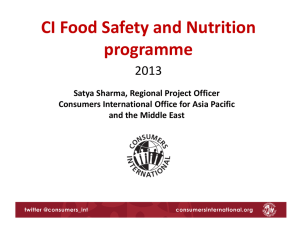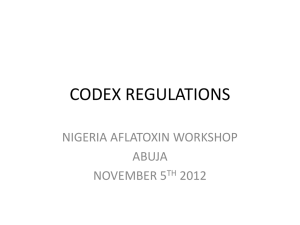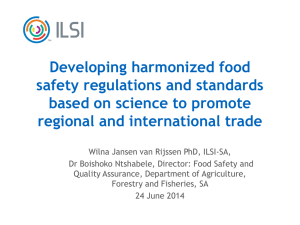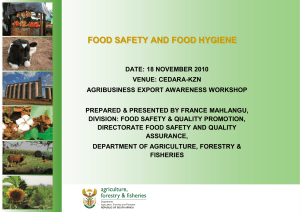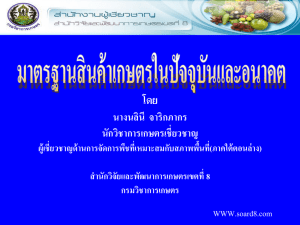Food Quality and Safety. (Presentation by Dr. N.S.
advertisement
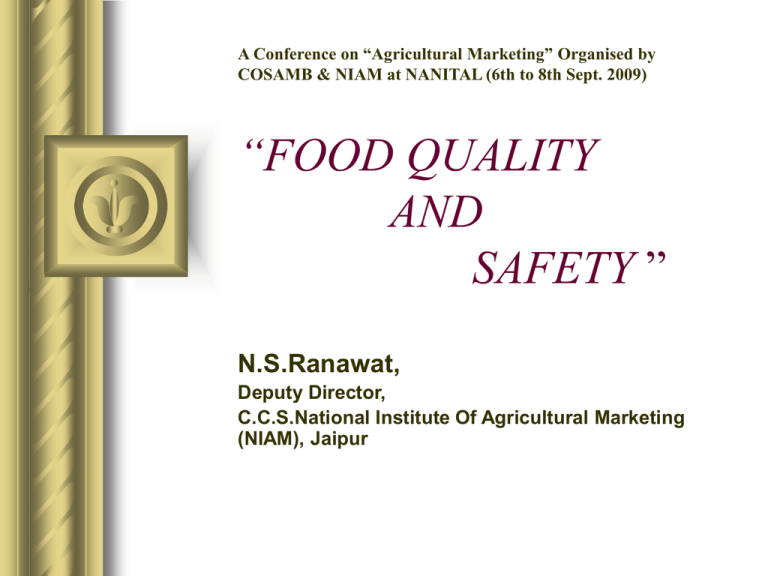
A Conference on “Agricultural Marketing” Organised by COSAMB & NIAM at NANITAL (6th to 8th Sept. 2009) “FOOD QUALITY AND SAFETY ” N.S.Ranawat, Deputy Director, C.C.S.National Institute Of Agricultural Marketing (NIAM), Jaipur Food safety Safety of food is a basic requirement of food quality. "Food safety" implies absence or acceptable and safe levels of contaminants, adulterants, naturally occurring toxins or any HAZARD that may make food injurious to health on an acute or chronic basis Food quality Food quality can be considered as a complex characteristic of food that determines its value or acceptability to consumers. Besides safety, quality attributes include: nutritional value and organoleptic properties such as appearance, colour, texture, taste The Importance of Food Quality and Safety for Developing Countries For domestic and international trade building up the trust and confidence of importers in the quality and safety of food supply systems Improving Food Quality and Safety makes economic sense also. INTERNATIONAL INSTITUTIONAL REGULATIONS ON FOOD & AGRI-PRODUCTS Codex Alimentarius Commission Office International des Epizooties (OIE) International Plant Protection Convention (IPPC) World trade organization CODEX ALIMENTARIUS COMMISSION The term Codex Alimentarius is taken from Latin and means food code. Codex Alimentarius brings together all the interested parties -scientists, technical experts, governments, consumers and industry representatives to help develop standards for food manufacturing and trade. these standards are more and more being used in international trade negotiations and also for setting of disputes by WTO Codex Alimentarius Commission (CAC) The Codex Alimentarius Commission was created in 1963 by FAO and WHO to develop food standards, guidelines and related texts such as codes of practice under the Joint FAO/WHO Food Standards Programme. The main purposes of this Programme are protecting health of the consumers and ensuring fair trade practices in the food trade, and promoting coordination of all food standards work undertaken by international governmental and non-governmental organizations. Office International des Epizooties (OIE) World Animal Health Organisation an intergovernmental organisation created by an international agreement in 1924 for addressing issues relating to animal health. An International Committee (IC) comprising permanent delegates appointed by the governments of the member countries- is the apex decision making body in OIE. International Plant Protection Convention (IPPC) located within FAO under the Plant Protection Service. The main thrust of IPPC is to provide a framework and forum for international cooperation, harmonisation and technical exchange in collaboration with the Regional Plant Protection Organisation (RPPOs) and the National Plant Protection Organisations (NPPOs). WTO International body dealing with Rules of trade between countries. 153 (till 23-07-2008) member countries. Provides permanent institutional framework for the multilateral trading system. Provides Rule based dispute settlement mechanism. WTO MAIN OBJECTIVES : Help trade flow as freely as possible. Help achieve further liberalization through negotiations. Dispute settlement. WTO AGREEMENTS Agreement on Agriculture. -Define the rules for trade of food and agricultural products. Agreement on SPS Agreement on TBT Agreement on SPS measures Was signed during the Uruguay round of trade negotiations Primary objective: safeguard health or life of humans, plants and animals Approach route: ensuring food safety Encourage member countries to follow international standards developed by CODEX, IOE and the International Plant Protection Convention SPS Agreement KEY FEATURES Basic Rights Harmonization Equivalence Risk Assessment Transparency TBT Agreement The Technical Barriers to Trade Agreement (TBT) tries to ensure that regulations, standards, testing and certification procedures do not create unnecessary hurdles in international trade GOOD AGRICULTURAL PRACTICES Good Agricultural Practices (GAPs) covers a wide gamut of onfarm and post-farm activities related to food safety, food quality and food security, the environmental impacts of agriculture and often various social objectives including animal health and welfare and agricultural workers rights Global GAP STANDARDS Global – organization of more than 80 countries, which are major growers, exporters, and importers. GlobalGAP – Good Agricultural Practices Standards for safe and sustainable agriculture. GOALS – Reduce risks of food safety lapses. – Objectively verify best practices. GlobalGAP STANDARDS Have environmental and social dimensions. Prevent degradation of soil. Ensure optimum utilization of water resources. Improve yield and quality. Food Safety Issues Residues of Pesticides Pesticides used to control fungal diseases, pests, weeds, etc. Difference in International and National standards MRLs being harmonised with Codex. IPM being implemented to reduce chemical pesticides. Organic farming is the best option Food Safety and laws implementing and controlling authorities in India Mandatory standards / Compulsory legislation: Food Safety Authority of India a. Prevention of Food Adulteration Act-1954. b. Essential commodity Act-1954. It includes various organization and quality standards or laws or acts, which “Implement and control” food laws and acts. Voluntary standards: Bureau of Indian Standards (B.I.S) Directorate of Marketing and Inspection (D.M.I)“Agmark” Eco-Mark, Recently the government of India has constituted a committee to harmonized all the food laws under one umbrella so that only one Authority or Ministry shall look after all food related issues which are concerned with formulation of quality standards and food safety issues. A “Food Safety and Standards Bill 2005” has already been prepared by the government of India and has been put up in the Parliament for its implementation in the country. The detailed information is available at the sitehttp://mofpi.nic.in/foodsfty.p The “National Codex Alimentarius Contact Point” in India is the Directorate General of Health Services (DGHS) in the Ministry of Health. However, the Ministry of Food Processing Industries is closely associated with the activities of Codex Alimentarius. It coordinates and promotes Codex activities in India in association with the National Codex Committee and facilitates India's input to the work of Codex through an established consultation process. For detailed information please visit the site www.codexindia.nic.in. Problems faced in implementing SPS Measures Inadequate advance warning about the new Measures. Lack of adequate time to adapt to SPS Measures. High cost of adaptation. Unwillingness on the part of the developed countries to accept equivalent measures of developing countries. Lack of adequate infrastructure required for conformity assessment procedures. Ineffective participation in activities of international standardizing bodies. Strategies / Action Plans for SPS Management 1. Participate in International standard-setting process 2. Develop appropriate legislation and standards 3. Conduct basic research, diagnosis and analysis 4. Develop / apply quarantine procedures, including those for emergency situations 5. Accredit food and pesticide residue testing laboratories 6. Develop / maintain pest or disease free areas 7. Notify WTO / trading partners on new SPS measures 8. Apply GAP, GMP, HACCP & QM at farm & enterprise level The Importance Of Food Quality And Safety for Developing Countries Export promotion Building up the trust and confidence of importers in the quality and safety of their food supply systems Ensures public health by prescribing safety requirements; Improving Food Quality and Safety makes economic sense also. finally, they can hide protectionist policies Worker Health and Safety Relationship Between Worker Health and Hygiene Employee Symptoms Indicating Potential for Contamination of Food Exclusion of Sick Workers from Food Handling Worker Training in Health and Hygiene First Aid Kit Drinking Water Sources and Potential Hazards Precautions for Handling Drinking Water in Fields and Packing Areas Personal Hygiene of Agricultural Workers Correct Handwashing Procedure When is Handwashing Required Basic Requirements for Sanitary Field Stations Harvesting and Cooling Harvesting Procedures – Manual versus Mechanical Harvesting In-Field Packing Operations Post-Harvest Water Quality Practices to Reduce Contamination by Processing Water Cooling Considerations Benefits of Produce Cooling Cooling Methods Hazards Associated with Specific Cooling Methods Wash or Cooling Water Temperature and Microbial Infiltration Good Manufacturing Practices / Good Hygiene Practices Produce Cleaning and Treatment Recommended Procedures for Cleaning Fruits and Vegetables Sanitizing Agents Use of Sanitizers to Reduce Microbial Pathogens on Fresh Produce Technologies to Treat Fresh Produce (Irradiation, Pulsed Light, etc) Hurdle Technology Packing, Storing and Transportation Sanitary Design Considerations for Facilities Proper Maintenance of Packing and Storing Facilities Sanitary Considerations for Equipment Cleaning and Maintenance of Equipment GMPs for Produce Containers Trash and Waste Handling Storage of Packing Material Produce Storage Transportation Shipping Container Sanitation Refrigerated and Controlled Atmosphere Transportation Equipment Cleaning and Sanitation Timing and Frequency of Cleaning and Sanitizing Cleaning Procedures Characteristics of Cleaning Agents Selection of Cleaning Agents for Specific Surfaces Sanitizing Procedures Selection of Sanitizing Agents Appropriate Use of Common Sanitizing Agents Introduction to Hazard Analysis and Critical Control Point (HACCP) Systems Prerequisites to HACCP Good Manufacturing Practices and Sanitation (US) Good Hygiene Practices (Codex) Other Prerequisite Programs Relationship of Prerequisite Programs to HACCP Program Preliminary Steps in Developing a HACCP Program Assemble the HACCP Team Food Product Description and Distribution Describe Intended Use and Consumers of Food Product Develop a Flow Diagram Which Describes the Process Verify the Flow Diagram HAZARD Three are three main types of hazards associated with fresh produce: - Biological hazards Chemical hazards Physical hazards Biological Hazards Microorganisms Microorganisms are small organisms that can be observed through a microscope In order to facilitate the study of microorganisms they are divided into five major classifications: Bacteria Yeasts Molds Parasites Viruses To prevent pathogen reproduction in produce, control: Nutrient availability, Humidity, Acidity, Temperature & Oxygen To Prevent the growth of Microorganisms Shigella Escherichia Coli (pathogenic) Campylobacter species Yersinia enterocolitica Listeria monocytogenes Staphylococcus aureus Clostridium species Bacillus cereus Vibrio species The surface of fruits and vegetables can be contaminated with pathogenic microorganisms due to contact with: Soil Water Manure Sewage fluids Air Humans Animals Parasitic Hazards Parasites most commonly associates with human infections include: Cryptosporidium Cyclospora Giardia Entamoeba Toxoplasma Sarcocysits Isospora Helminthes: - Nematodes (i.e. Ascaris lumbricoides, Thricuris trichiura) - Plathemlminthes (i.e.Fasciola hepatica and Cysticercus spp.) Viral Hazards Viruses that have been reported as transmitted by foods include: Hepatitis A Norwalk virus and Norwalk-like virus Rotaviruses, astroviruses, enteroviruses (polioviruses, echoviruses and coxsackie viruses), parvoviruses, adenoviruses and coronaviruses. Chemical Hazards Some Naturally Occurring Chemicals Hazards Allergens (e.g. weeds) Mycotoxins (e.g. aflatoxin) Mushroom toxins Phytohaemagglutinin Alkaloids Added Chemical Hazards Polychlorinated biphenyls (PCBs) Agricultural chemicals Pesticides Fertilizers Antibiotics Prohibited Substances Direct Indirect Toxic elements and compounds Lead Zinc Cadmium Mercury Arsenic Cyanide Contaminants Lubricants Cleaners Sanitizers Coatings Paints Refrigerants Water or steam treatment chemicals Pest control chemicals From packaging materials Plasticizers Vinyl chloride Painting/coding inks Adhesives Lead Tin Physical Hazards :Material Glass Wood Stones Insulation Plastic Injury potential Cuts, bleeding; may require Surgery to find or remove Cuts, infection, choking; may Choking, broken teeth Choking long-term if asbestos Choking, cuts infection; may require surgery to remove Personal effects, Choking, cuts, broken teeth Employees may require surgery to remove Sources Bottles,Jars, light, fixtures, utensils, Gauge, covers, etc. Field sources, pallets, boxes, building materials Fields, buildings Building materials Packaging, pallets, equipment i.e. jewelry, hair clips, pens Health Effects of Food borne Disease :Some Effects of Food bore Disease Vomiting Gastroenteritis Diarrheal disease Non-intestinal disease, i.e. neurological conditions, pre-mature labor, and stillbirths Costs of Food borne Disease:Costs for Individuals Medical costs Missed work and lost wages Travel to get care Expenses for care taker Chronic disease Cost of Society Loss of productivity Cost of disease investigation Loss of revenue due to business closure and product avoidance Chronic disease Potential for physical contamination ? Potential for physical contamination ? Physical hazard possible ? GAP- Facilities and Sanitation LACK OF ADEQUATE STORAGE FACILITIES GAP- Facilities and Sanitation SANITATION PROBLEM AT MANDI GAP- Facilities and Sanitation MODERN FACILITIES AT RELIANCE STORE AT RAJA PARK GAP- Facilities and Sanitation LACK OF TECHNICAL KNOWLEGE GAP- Facilities and Sanitation LACK OF STORAGE FACILITIES AND GENERAL AWARENESS GAP- Facilities and Sanitation LACK OF FARM MANAGEMENT KNOWLEDGE GAP- Facilities and Sanitation HOUSE OF PATHOGENS AFTER HARVESTING Kolar –APMC (Karnataka) Plastic Crates Source of Contamination:- FROM FARM TO FORK Farm GAPS Pesticide use Manure use Harvesting Processing Packaging Storage Transport Worker Hygiene APMC HACCP •Grading and Sorting Tables •Elevated auction platforms •Washing and Disinfection •Washing of Crates •Worker Hygiene •Cold Storage Retail Market HACCP •Grading and Sorting Tables •Washing and Disinfection •Worker Hygiene •Cold Storage Table •Consumer Education •Consumer Awareness THANKS
